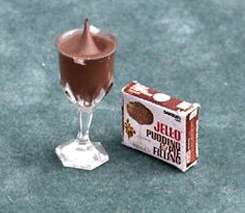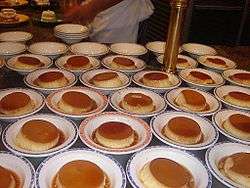Pudding
|
Brazilian pudim de leite (milk pudding) | |
| Type | Pudding |
|---|---|
|
| |

Pudding is a kind of food that can be either a dessert or a savory dish. The word pudding is believed to come from the French boudin, originally from the Latin botellus, meaning "small sausage", referring to encased meats used in Medieval European puddings.[1]
In the United Kingdom and some of the Commonwealth countries, the word pudding can be used to describe both sweet and savory dishes. Unless qualified, however, the term in everyday usage typically denotes a dessert; in the UK, pudding is used as a synonym for a dessert course.[2] Dessert puddings are rich, fairly homogeneous starch- or dairy-based desserts such as rice pudding, steamed cake mixtures such as Treacle sponge pudding with or without the addition of ingredients such as dried fruits as in a Christmas pudding.[2] Savory dishes include Yorkshire pudding, black pudding, suet pudding and steak and kidney pudding.
In the United States and some parts of Canada, pudding characteristically denotes a sweet milk-based dessert similar in consistency to egg-based custards, instant custards or a mousse, often commercially set using cornstarch, gelatin or similar collagen agent such as the Jell‑O brand line of products.
In Commonwealth countries these puddings are known as custards (or curds) if they are egg-thickened, blancmange if starch-thickened, and jelly if gelatin based. Pudding may also refer to other dishes such as bread pudding and rice pudding, although typically these names derive from the origin as British dishes.
History
The modern usage of the word pudding to denote primarily desserts has evolved over time from the almost exclusive use of the term to describe savoury dishes, specifically those created using a process similar to sausages where meat and other ingredients in a mostly liquid form are encased and then steamed or boiled to set the contents. The most famous examples still surviving are black pudding, which was a favourite of King Henry VIII, and haggis.
Baked, steamed and boiled puddings
The original pudding was formed by mixing various ingredients with a grain product or other binder such as butter, flour, cereal, eggs, and/or suet, resulting in a solid mass. These puddings are baked, steamed or boiled. Depending on its ingredients, such a pudding may be served as a part of the main course or as a dessert.
Boiled or steamed pudding was a common main course aboard ships in the Royal Navy during the 18th and 19th centuries. Pudding was used as the primary dish in which daily rations of flour and suet were prepared.
Steamed pies consisting of a filling completely enclosed by suet pastry are also known as puddings. These may be sweet or savory and include such dishes as steak and kidney pudding.
Types
Savory
- Batter puddings, including Yorkshire pudding and popovers
- Black pudding
- Boudin
- Cheese pudding
- Corn pudding
- Goetta
- Groaty pudding
- Haggis
- Kishke
- Kugel
- Liver pudding, also known as liver mush, common in the southern United States, particularly in Virginia and North Carolina
- Moin moin
- Pease pudding
- Pennsylvania Dutch hog maw
- Polenta (mămăligă, cornmeal mush)
- Red pudding
- Scrapple
- Spoon bread, common in the southern United States, made with white cornmeal.
- Steak and kidney pudding
- Toad in the hole
- White pudding
- Yorkshire pudding
Dessert
- Banana pudding
- Bread pudding
- Bread and butter pudding
- Butterscotch pudding, a type of blancmange prepared with butterscotch flavoring
- Cabinet pudding
- Chè
- Chocolate pudding, a type of blancmange prepared with chocolate flavoring, usually in the form of cocoa powder, chocolate syrup, or various types of baking chocolate
- Christmas pudding (also "duff" in Great Britain, "plum pudding" in the United States)
- Clootie dumpling
- Cottage pudding
- Indian pudding
- Figgy duff
- Figgy pudding
- Fruit pudding
- Hasty pudding
- Jam Roly-Poly
- Persimmon pudding
- Rice pudding
- Sago pudding
- Spotted dick
- Sticky toffee pudding
- Summer pudding
- Sussex Pond Pudding
- Sweet potato pudding
- Tapioca pudding
- Tembleque
- Treacle sponge pudding
- Vanilla pudding, a kind of blancmange prepared with vanillin, vanilla extract, or vanilla beans
Creamy puddings

The second and newer type of pudding consists of sugar, milk, and a thickening agent such as cornstarch, gelatin, eggs, rice or tapioca to create a sweet, creamy dessert. These puddings are made either by simmering on top of the stove in a saucepan or double boiler or by baking in an oven, often in a bain-marie. These puddings are easily scorched on the fire, which is why a double boiler is often used; microwave ovens are also now often used to avoid this problem and to reduce stirring.
Creamy puddings are typically served chilled, but a few, such as zabaglione and rice pudding, may be served warm. Instant puddings do not require boiling and can therefore be prepared more quickly.
This pudding terminology is common in North America and some European countries such as the Netherlands, whilst in Britain egg-thickened puddings are considered custards and starch-thickened puddings called blancmange.
Types
Savory
Dessert
- Angel Delight
- Bavarian cream
- Blancmange
- Chinese flan
- Crema catalana
- Crème anglaise
- Crème brûlée (French for "burned/burnt cream")
- Creme caramel
- Custard
- Flan
- Fool
- Haupia
- Junket
- Jell-O
- Mahallebi
- Mango pudding
- Mousse
- Ogi
- Panna cotta
- Pot de creme
- Pudding Pops
- Quesillo
- Rice pudding, including kheer
- Semolina pudding
- Syllabub
- Tocinillo de cielo
- Trifle
- Vla
- Zabaglione (sabayon)
Cultural references
- The proverb "The proof of the pudding is in the eating" dates back to at least the 14th century. The phrase is widely attributed to the Spanish author Cervantes in his novel The Ingenious Gentleman Don Quixote. The phrase is often incorrectly stated as "the proof is in the pudding."[3]
- Pudd'nhead Wilson written by Mark Twain reflects the term's use as a metaphor for someone with the mind of a fool.
See also
References
- ↑ Olver, Lynne (2000). "The Food Timeline: pudding". Retrieved 2007-05-03.
- 1 2 Oxford English Dictionary
- ↑ "Origin Phrase "Proof is in the Pudding"".
External links
| Wikimedia Commons has media related to Puddings. |
![]() Chisholm, Hugh, ed. (1911). "Pudding". Encyclopædia Britannica (11th ed.). Cambridge University Press.
Chisholm, Hugh, ed. (1911). "Pudding". Encyclopædia Britannica (11th ed.). Cambridge University Press.

